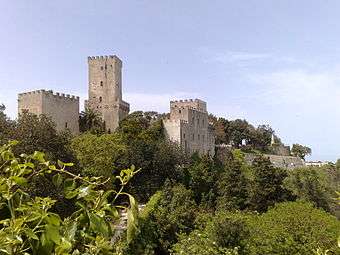Adragna family
The Adragna family is an Italian noble house. The family ruled the territory of Altavilla in Sicily, Italy.
| Adragna Italian: Casa di Adragna | |
|---|---|
| Sicilian noble family | |
 Motto: "Do not keep silent" (Latin: Non Tacebo) | |
| Parent house | Pepoli |
| Country | Former countries
|
| Founded | 1100 |
| Current head | Francesco Adragna |
| Titles | |
| Style(s) | "Grace" Vostra Signoria Don |
History
The family can trace its ancestry to the Norman conquest of Sicily and is descended from the ancient nobility of Bologna.[1] Related to the Pepoli family of Bologna, the family's noble ancestry dates back over 800 years.[2][3][4]
The family is found in Salemi, Mazzara, and today in Trapani. Nobile Giuseppe Adragna was among the first jurors of Salemi in the years 1567–68; 1573–74.[5] In Mazzara, Pietro Adragna held the rank of Captain in charge of Justice on 7 October 1665.[6] In recognition of the family's feudal rights, Francesco Adragna was granted the title of Baron of Altavilla Salina by King Ferdinand I of the Two Sicilies.[7] Today, the Sicilian Heraldry Commission lists the family in the Golden Book of Italian Nobility, now preserved in the Italian historical archives in Rome.[8] Similarly to other Italian Norman families, the House of Adragna has historic links with the Knights Hospitaller (the present day Order of Malta) through participation in the Crusading movement in the Holy Land.[9]
Gioacchino Napoleone Pepoli, a cousin of the Adragna family, was a senator of the Kingdom of Italy, Mayor of Bologna, and Italian envoy to Russia. Moreover, he was also a grand-nephew of Napoleon Bonaparte through his mother, Princess Louisa Julie Caroline Murat the daughter of Prince Joachim Murat - Napoleon's brother-in-law.[10]
Notable buildings


Castello Grifeo in Partanna, Trapani, a medieval castle dating from c.1300, was owned by the family from 1890 until the property was donated to the Cultural Heritage Department of Trapani in 1991.[11]
The last King of Italy, Umberto II of Italy visited the Castle in 1941 while Crown prince.[12] Through relation to the Pepoli family, the Norman Castle in Erice, which includes the Torri Pepoli, is partially owned by the Adragna family.[13] In Valderice, the Villa Betania, was built by Baron Girolamo Adragna in the second half of the 19th century.[14][15]
Notable buildings and structures associated with the family include;
- Villa Adragna, Valderice
- The complex of castles/towers including Venus Castle, Castello del Balio - also known as Torri Pepoli, and the Torretta Pepoli in Erice[16]
In literature, media and popular culture
The character Baron Adragna appears in Vito Bruschini's fictional novel The Prince (published in Italian as The Father – Il Padrino dei Padrini è).[17] The book depicts the rise of the Italian Fascist Party in Sicily, following the story of Ferdinando Licata, a Sicilian nobleman known as the prince.[18] Baron Adragna appears as a conservative nobleman opposed to popular rule.[19]
Notable Members
.png)
- Giuliano Adragna, Notary of Trapani c.1486
- Giuseppe Adragna III, Juror of Salemi, 1567–68 and 1573–74
- Francesco Adragna I, Barone della salina di Altavilla
- Stefano Adragna, Italian Renaissance patron – commissioned sculptors Bartolomeo Berrettaro and Giuliano Mancino, c.1517, for the Church of Santa Maria della Grazia, Church of the Annunciation (Alcamo) and the Cappella Adragna.[20]
- Giuseppe Beccadelli di Bologna, VI Prince of Camporeale, III Duca d'Adragna
- Antonio Maria Adragna (1818–1890), 104th Minister General of the Order of Friars Minor
- Vincenzo Adragna, Author, Historian and academic, Università di Palermo
- Benedetto Adragna, Italian Senator and Quaestor of the Senate (2008–2013)
- Tony Adragna, Coach, Athlete and academic, [Indiana University]
See also
- Baron of Altavilla Salina
- Italian nobility
- Barone della salina di Altavilla
References
- Paul Oldfield, 'The Bari charter of privileges of 1132: articulating the culture of a new Norman monarchy', Historical Research, 1 (2015), p.581.
- "Andiamo Sicilia".
- Paul Oldfield, 'The Bari charter of privileges of 1132: articulating the culture of a new Norman monarchy', Historical Research, 1 (2015), 577–597.
- "Museo Pepoli, custode dei tesori di Trapani - Notizie Trapani – La Sberla". www.lasberla.com.
- Dr. A. Mango Casalgerardo, Nobility of Sicily, Accomando to Adragna
- "Nobiliario di Sicilia".
- "Tenute Adragna – Sicilia Trapani Trapani – Vini, Prodotti Tipici, Enoturismo".
- Lorenzo, Gigante. "Personaggi Trapanesi – Vincenzo Adragna".
- Jonathan Riley-Smith, The Sovereign Military Order of Malta: A short history, 2001.
- http://badigit.comune.bologna.it/sindaci/pepoli_g.htm%7C%5B%5D Biografia e bibliografia di Gioacchino Napoleone Pepoli su Archiweb – Raccolte digitali della Biblioteca dell'Archiginnasio di Bologna
- "Castello Grifeo Partanna".
- "Grifeo di Partanna".
- Sims, Fiona (12 August 2006). "Trapani on a plate" – via The Guardian.
- Theotokis G. The Norman Invasion of Sicily, 1061–1072: Numbers and Military Tactics, War in History, 2010;17(4):381–402.
- "About Valderice" (PDF).
- "Castelli Sicilia". www.castelli-sicilia.com.
- Bruschini, Vito (27 September 2016). "The Prince: A Novel". Simon and Schuster – via Google Books.
- Staff (5 April 2015). "Review: 'The Prince," By Vito Bruschini".
- Bruschini, Vito (27 September 2016). "The Prince: A Novel". Simon and Schuster – via Google Books. p. 16, p. 141.
- Vincenzo Regina, Profilo storico di Alcamo e sue opere d'arte dalle origini al secolo XV, Edizioni Accademia di Studi "Cielo d'Alcamo", 1972.